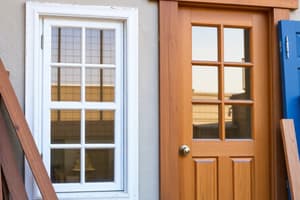Podcast
Questions and Answers
Which mineral is primarily used in the composition of glass for window panels?
Which mineral is primarily used in the composition of glass for window panels?
- Calcium fluoride
- Silica (correct)
- Polyvinyl chloride
- Aluminum
What is a significant characteristic of fiberglass when used in door panels?
What is a significant characteristic of fiberglass when used in door panels?
- It warps easily in heat.
- It requires extensive maintenance.
- It is highly conductive.
- It is made of fine glass fibers. (correct)
Which material is known for providing insulation and moisture resistance in window frames?
Which material is known for providing insulation and moisture resistance in window frames?
- Vinyl (PVC) (correct)
- Wood
- Natural stone
- Aluminum
What is a common application for aluminum in window and door constructions?
What is a common application for aluminum in window and door constructions?
Which of the following is an advantage of using composite materials in window and door panels?
Which of the following is an advantage of using composite materials in window and door panels?
What is a key consideration when selecting materials for windows and doors?
What is a key consideration when selecting materials for windows and doors?
Which mineral is often added to wood to improve performance in window and door frames?
Which mineral is often added to wood to improve performance in window and door frames?
What property of materials used for window and door panels contributes to energy efficiency?
What property of materials used for window and door panels contributes to energy efficiency?
Study Notes
Overview of Minerals Used in Window and Door Panels
-
Glass
- Primary material for windows.
- Composed mainly of silica (SiO2).
- Additional minerals: soda (sodium carbonate) and lime (calcium oxide) for durability and workability.
-
Aluminum
- Commonly used in frames for windows and doors.
- Lightweight, resistant to corrosion, and easy to recycle.
- Alloyed with other metals to enhance strength.
-
Fiberglass
- Composed of fine glass fibers.
- Used in door panels for insulation and strength.
- Non-conductive and resistant to warping.
-
Wood
- Natural material used in traditional door and window frames.
- Can be treated with minerals (e.g., fire retardants) to improve performance.
- Requires maintenance to prevent decay and damage.
-
Vinyl (PVC)
- Synthetic polymer made from polyvinyl chloride.
- Utilized for frames and panels due to insulation properties and resistance to moisture.
- Often contains calcium carbonate as a filler.
-
Composite Materials
- Combine different materials (e.g., wood fibers with plastic).
- Enhance durability, thermal performance, and aesthetic appeal.
- May include minerals and other additives to improve characteristics.
Key Characteristics of Minerals Used
-
Thermal Insulation
- Many minerals enhance the insulating properties of panels.
- Important for energy efficiency and comfort in buildings.
-
Moisture Resistance
- Minerals like silica and certain synthetics provide resistance to water.
- Essential for durability in various weather conditions.
-
Structural Integrity
- Use of metals (e.g., aluminum) supports strength and stability.
- Fiberglass and composite materials offer lightweight yet strong solutions.
-
Aesthetic Versatility
- Various minerals allow for a range of finishes, styles, and colors.
- Ability to mimic traditional materials while providing modern performance.
Considerations for Selection
-
Environmental Impact
- Preference for sustainable materials and recycling capabilities.
- Evaluation of life-cycle impacts of minerals used.
-
Cost
- Budget considerations influence the choice of materials.
- Balance between initial investment and long-term maintenance costs.
-
Application Specificity
- Different environments may require specific materials (e.g., coastal areas need corrosion-resistant options).
Summary
- A variety of minerals are essential in the construction of window and door panels, each contributing unique properties.
- Understanding the characteristics and applications of these minerals is crucial for effective material selection in building projects.
Overview of Minerals Used in Window and Door Panels
-
Glass:
- Main component of windows; primarily composed of silica (SiO2).
- Enhanced with soda (sodium carbonate) and lime (calcium oxide) for improved durability and workability.
-
Aluminum:
- Widely used for window and door frames; known for being lightweight and corrosion-resistant.
- Often alloyed with other metals to enhance strength and durability.
-
Fiberglass:
- Made from fine strands of glass; used in door panels for effective insulation and structural strength.
- Non-conductive, which helps prevent warping and maintains integrity over time.
-
Wood:
- Traditional material for door and window frames; offers a natural aesthetic.
- Can be treated with minerals, such as fire retardants, to enhance performance but requires regular maintenance to combat decay.
-
Vinyl (PVC):
- A synthetic polymer derived from polyvinyl chloride; valued for its insulating properties and moisture resistance.
- Often contains filler materials like calcium carbonate, which supports structural integrity.
-
Composite Materials:
- Combination of materials, such as wood fibers and plastics, designed to enhance durability and thermal efficiency.
- Includes various minerals and additives to improve physical characteristics.
Key Characteristics of Minerals Used
-
Thermal Insulation:
- Many minerals improve insulating properties, critical for energy efficiency in buildings.
-
Moisture Resistance:
- Minerals like silica and synthetic compounds provide significant resistance to water, ensuring longevity in diverse weather conditions.
-
Structural Integrity:
- Metals, particularly aluminum, provide strength and stability; fiberglass and composites offer lightweight yet robust alternatives.
-
Aesthetic Versatility:
- The variety of minerals allows for a plethora of finishes, colors, and styles while mimicking traditional materials and improving performance.
Considerations for Selection
-
Environmental Impact:
- There is a focus on using sustainable materials and evaluating the life-cycle effects of minerals.
-
Cost:
- Material choice hinges on budget constraints, balancing initial costs with potential long-term maintenance expenses.
-
Application Specificity:
- Material selection should be tailored to specific environments, such as prioritizing corrosion resistance in coastal areas.
Summary
- A diverse range of minerals is pivotal in constructing window and door panels, each with distinct properties that enhance functionality.
- Knowledge of these minerals and their applications aids in making informed material choices during building projects.
Studying That Suits You
Use AI to generate personalized quizzes and flashcards to suit your learning preferences.
Description
Explore the various minerals used in the manufacturing of window and door panels. This quiz covers materials such as glass, aluminum, fiberglass, wood, and vinyl, highlighting their properties and applications. Test your knowledge on how these materials contribute to the durability and functionality of modern constructions.




